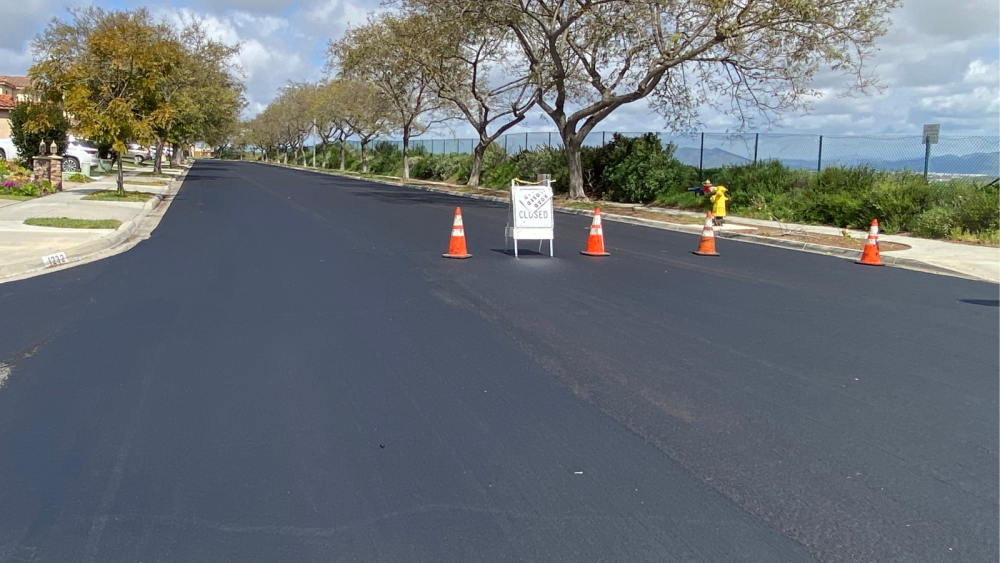Road Repair Projects Continue in Otay Mesa, Del Mar Mesa, Torrey Hills and Carmel Valley
March 13, 2024 | City News Team

Several City of San Diego communities will soon have improved and safer streets as two slurry seal projects continue over the next two weeks, part of an overall effort to repair and resurface roads citywide. Starting this week, the City will begin resurfacing streets in and around Otay Mesa and the Carmel Valley area.
Slurry seal is used to prevent the deterioration of streets, which is vital to improving the overall condition of San Diego’s network of roads. It reduces the need for a more costly asphalt overlay and reconstruction for badly deteriorated streets. Information about different types of street repair can be found on the Transportation webpage.
Slurry seal is often completed in phases over several days or weeks. Multiple slurry seal projects are happening across the City simultaneously and are often coupled with other upgrades to increase safety and mobility for all modes of transportation.
The latest work as part of Slurry Seal Projects 2323 and 2324 will be completed, weather permitting, through the month of March. The following roads will be resurfaced:
- Tamarand Way
- Thelborn Way
- Wolviston Way
- Standlake Street
- Ilex Avenue
- Surfpoint Way
- Sea Bird Way
- Surf Crest Drive
- Arklow Place
- Royston Drive
- Switzerland Drive
- Starfish Way
- Sea Reef Drive
- Cove View Place
- Surfside Drive
- Cove View Way
- Sea Drift Way
- Surfwood Lane
- Sea Water Lane
- Sea Strand Lane
- Angler Place
- Hidden Trails Road
- Seagreen Place
- Jade Cove Court
- Seahill Court
- Seafire Point
- Seaglen Way
- Seafield Place
- Sea Reef Drive
- Surftide Lane
- Surfwood Lane
- Beryl Cove Point
- Island Ketch Court
- Seagreen Place
- Surfbreaker Point
- Surf Shoal Point
- Surfwood Lane
- Surfside Drive
- Sea Robin Court
- Sea Lily Court
- Sea Maid Court
- Sea Coral Drive
- Sea Urchin Drive
- Breakers Way
- Royston Drive
- Hidden Trails Road
- Via Cangrejo
- Aquitaine Court
- Angouleme Court
- Lorient Court
- Anderson Ridge Place
- Del Mar Mesa Road
- West Ocean Air Drive
- Del Mar Mesa Road
- Ocean Bluff Avenue
- Calle Mejillones
- Corte Mejillones
- Corte Luz Del Sol
- Vereda Luz Del Sol
- Calle Mar De Maripos
- Via Mar De Delfinas
- Corte Mar Delfinas
- East Ocean Air Drive
- Vereda Mar Del Sol
- Corte Sol Del Dios
- Corte Langostino
- Calle Mar De Mariposa
- Carmel Mountain Road
- Sand Crab Place
- Abalone Landing Terrace
Slurry seal is a cost-effective pavement preservation method consisting of asphalt emulsion, sand and rock. This mixture is applied to the street surface at an average thickness of a quarter inch and extends the life of already in-good-condition streets.
Streets are selected for resurfacing through a pavement management system that helps determine when to schedule streets. Each street segment is assigned a Pavement Condition Index (PCI) score based on the pavement’s roughness and cracks. Earlier this year, the City’s Transportation Department announced the results of a comprehensive survey of pavement conditions in San Diego where all streets across the City were scored according to the Pavement Condition Index.
To prioritize street paving, the recent PCI scores are used in conjunction with other factors, such as traffic volume, road type, equity, climate resiliency, mobility, maintenance history, other construction projects, and available funding. Repairs are often grouped within a neighborhood to include streets in similar conditions or performed after other projects, such as pipeline replacement.
View a map of past, current and future street repair in your neighborhood by visiting the City’s interactive StreetsSD map.
Filter by Category
Airports (1)
Arts and Culture (9)
Business (20)
City Planning (1)
Environment (46)
Human Interest (7)
Library (14)
Parks and Recreation (21)
Personnel (11)
Public Safety (20)
Public Works (58)
Streets (1)
Technology (4)
Transportation (1)
Airports (1)
Arts and Culture (9)
Business (20)
City Planning (1)
Environment (46)
Human Interest (7)
Library (14)
Parks and Recreation (21)
Personnel (11)
Public Safety (20)
Public Works (58)
Streets (1)
Technology (4)
Transportation (1)
